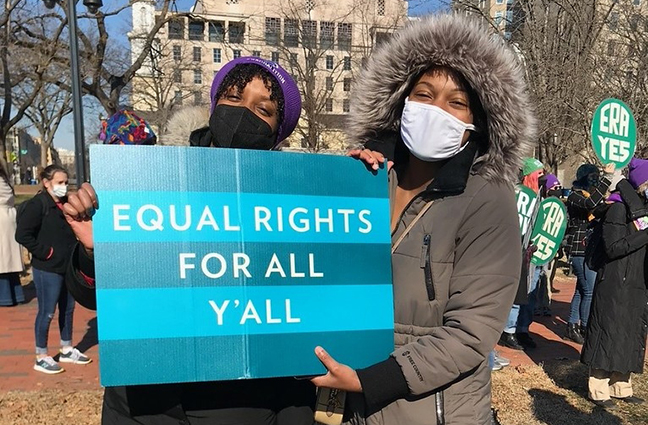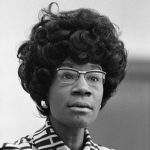If you’ve been keeping up with the news, you’re probably aware of the recent attacks on “Diversity, Equity, and Inclusion” (DEI) policies. But what is DEI, how does it really impact us and our democracy? This blog will provide more clarity into the concept, who’s opposing it, and why it’s important.
What is DEI?
Diversity, Equity, and Inclusion are three unique concepts that are often confused with one another. The following definitions are derived from the nonprofit Everyday Democracy:
- Diversity: Recognition and acceptance that multiple perspectives, identities, and cultural groups exist. Diversity has us consider the degree to which a wide variety of opinions and identities, such as race, ethnicity, age, gender, and more, are represented.
Example: A rally is attended by people aged 18-85, so there is a wide range of age diversity at the event. However, almost all attendees are white, so there is a low level of racial diversity. - Equity: Recognizes that people face various barriers to achieving success. Equity is about providing fair treatment, access, opportunity, and advancement for all people who experience disadvantage. This may look like barriers being eliminated or assistance provided that “level the playing field” so everyone can thrive.
Example: College A launched a STEM program, but over 90% of applicants and students were male. By offering special scholarships for women pursuing scientific degrees, College A increased the number of female applicants, thereby growing equity in fields where women are normally underrepresented. - Inclusion: Recognizes that all people have perspectives and viewpoints that matter and should be heard. Inclusion is about providing a context where differences are welcomed, differing perspectives are respectfully heard, and every individual feels a sense of belonging.
Example: “Marcy,” a League member and wheelchair user, notices that her perspective in meetings is always valued, she never feels othered by fellow members, and that all meetings and events are held in places that meet her access needs. For these and more reasons, she feels this environment is inclusive.
While DEI seems like a new concept, it was actually born out of the Civil Rights Act of 1964. Activists like former League member Shirley Chisholm were instrumental in its expansion to cover gender equity. Workplace DEI programs and trainings expanded in the 21st century, and in the 2010s they became more prominent than ever. In recent years, DEI efforts have been closely linked to movements like #MeToo and #BlackLivesMatter, as well as advances like the legalization of same-sex marriage.
Yet in recent years, DEI efforts have been directly under attack. In 2023, the Supreme Court struck down affirmative action programs. Upon entering his second term, President Trump released an Executive Order stopping DEI programs across the government. Government-funded nonprofits have been asked to remove DEI-related materials from their websites and trainings, even when those materials are pertinent to the nonprofits’ work. As a result, several companies have scaled back their DEI efforts.
Why is DEI Under Threat?
Certain public figures seem to misunderstand the purpose of “equity” in DEI. They believe that equitable solutions like affirmative action, scholarships, or other forms of support that benefit historically marginalized groups are unfairly prioritizing certain groups. For example, some detractors of affirmative action believed it unfairly prioritized Black and brown people over white or East Asian ones.
These people are ignoring the context in which programs like affirmative action exist. These policies were designed to expand opportunities and create more representative spaces — to even an uneven playing field rather than slight anyone. Until the 19th century, women were not allowed to enroll in college. And for minority women, it was even tougher. For example, affirmative action was created in a country where many Ivy League institutions didn’t allow Black or female students, regardless of race, until as late as the 1980s. Even with affirmative action in place, Black and Hispanic people were still underrepresented in top colleges as of 2017.
 Another reason certain people opposed DEI is because of its association with the political left. Yet diversity, equity, and inclusion aren’t partisan; no one side “owns” DEI. Access to multi-racial, accessible, and inclusive environments is everyone’s right, regardless of who they vote for. There are millions of voters who, as women, veterans, disabled people, older Americans, religious minorities, Black and brown folks, and more, benefit from DEI.
Another reason certain people opposed DEI is because of its association with the political left. Yet diversity, equity, and inclusion aren’t partisan; no one side “owns” DEI. Access to multi-racial, accessible, and inclusive environments is everyone’s right, regardless of who they vote for. There are millions of voters who, as women, veterans, disabled people, older Americans, religious minorities, Black and brown folks, and more, benefit from DEI.
I’ll dive into that in the next installment of this series, where I’ll discuss how DEI programs impact everyday people. I’ll explore its impact on democracy and how we can support it in this high-stakes moment.
– Celina Stewart LWVUS
All League News


